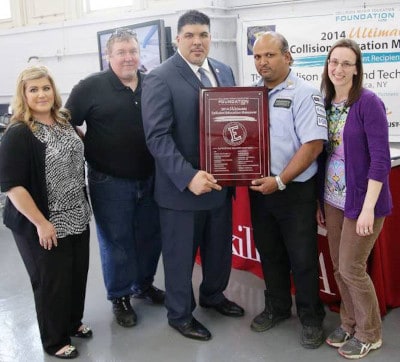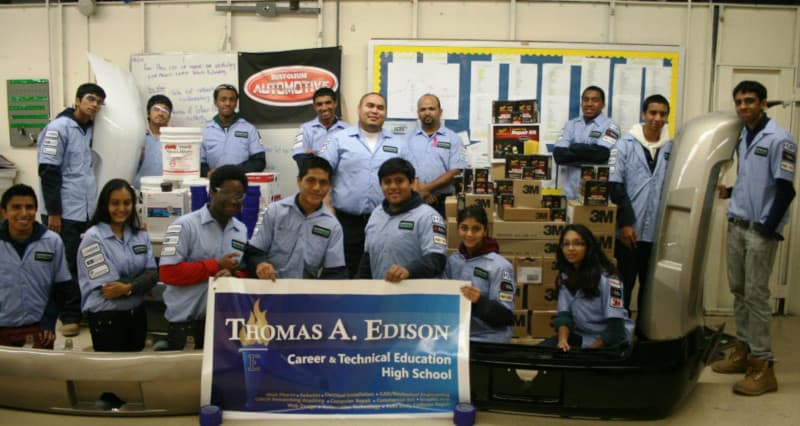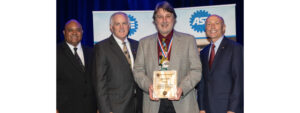A lot has changed for Thomas Edison CTE’s program since it won the Collision Repair Education Foundation’s 2014 Makeover Grant
Hoffman Estates, Ill.—For many years, Thomas Edison Career and Technical Education High School in Jamaica, N.Y., offered only one year of collision classes. As juniors, students decided whether to study automotive or collision during their senior year. In 2012, Assistant Principal Moses Ojeda agreed with Automotive Collision Instructor Barry Roopnarine that “one year was not sufficient to get students trained for an entry-level job in collision repair.”
Upgrading the collision program to a three-year track necessitated “a major revamp from the ground up,” Roopnarine recounted. “We required new tools, equipment, supplies, and other necessities to help the program run smoothly and to ensure we were providing students with the education they’d need to be successful in their future careers.”
Fortunately, Roopnarine learned about the Collision Repair Education Foundation (CREF), and when he received reminders to provide information about Thomas Edison CTE, “I completed the school survey and filled some other things out,” he said. “Then, every so often, the school would receive a package containing supplies or safety items being donated to the program from the collision industry through the foundation.”

Roopnarine remembers applying for the foundation’s 2014 Makeover Grant. “It was a lot of work. The foundation collects data and references to obtain a good snapshot of the collision programs that applied. At the awards ceremony, I watched all the schools get recognized for various smaller grants, and then when it was time for the big one, all I heard was ‘Thomas Edison’ before I went into a state of shock that prevented me from hearing the rest of the school name. It was surreal — I wanted to share the news [ we received it] with everyone back home immediately, but there was a three-hour time difference preventing me from spreading the excitement that night.”
The grant could not have happened at a better time because, with the expansion of the his school’s program, it was responsible for providing a solid foundation. “We received tools, supplies, and various pieces of equipment that helped modernize the classroom to meet industry standards,” Roopnarine added. “Without these donations, the revamped collision program at Thomas Edison would not have had the strong start that it enjoyed. The industry’s generous donations, facilitated by the foundation, provided our students with the necessities to be able to learn the trade and sharpen their skills. Without the grant, budgetary constraints would have prevented many of these items from ever making it to the classroom.”
The donations didn’t just result in a revamp to the school’s shop — the Makeover Grant also resulted in a favorable impact on students’ morale. According to Roopnarine, “The students were always as excited as I was when there was a delivery, and that was before the grant. Winning the grant just meant more deliveries, and it was always exciting to see new things come into the shop class. Students saw the industry’s effort to ensure they had what was necessary for their education, and that motivated them to want to succeed. It is frustrating when you are trying to teach students something that requires hands-on activities, but you lack the tools and supplies to do so. CREF has helped alleviate that problem for Thomas Edison and many other schools.”
Receiving the grant brought financial support and vital donations to the collision program, but the Makeover Grant provided Thomas Edison CTE with an unforeseen benefit, as well. “Upon receiving this grant, industry support came along with it,” Roopnarine said. “Training opportunities, internships, and additional supplies were provided, which helped us develop great working relationships with members of the industry. Their involvement constantly strengthens the program.”
“The support received from the foundation has also played a critical role in our success as a SkillsUSA chapter,” Roopnarine added. “The donations have helped prepare our students for the various competitions, including a Gold Medal at the 2013 SkillsUSA National Refinishing Competition. It has also allowed top placement at multiple state conferences. Without the support of the grant and prior donations, this would have added additional challenges to overcome.”
Collision repair shops consistently say that the industry needs more skilled technicians entering the field, while collision schools are in desperate need of more equipment, supplies, and internship opportunities, according to Roopnarine, who said, “The solution is literally staring us in the face. We need to get the shops and the schools together. When the industry works with the schools, it helps prepare students for those positions that are waiting to be filled. Yes, there is a technician shortage, but together, we can fill that gap.”
Roopnarine works with local shops to provide job shadowing and internship opportunities for his students, but he’s always in need of more industry supporters to help ensure students are prepared to enter a shop with the skillset needed to safely repair vehicles after graduation. “We have been fortunate to work with some of the top body shops around, including Mid Island Collision and High Velocity Autobody. These facilities have welcomed our students in for mentoring and job shadowing and have allowed students to form a connection between classroom and industry.”
Many of those shops also participate on Thomas Edison CTE’s advisory board. The school’s “advisory board consists of industry professionals who critique our program and make suggestions for improvements. Students can job shadow, and they work internships at these shops which serves as a valuable resource on its own,” Roopnarine said.
Being a recipient of the CREF’s 2014 grant also provided additional networking opportunities for Roopnarine. “Getting involved with the foundation not only allowed me to form great partnerships with industry members but also with instructors from across the country, through a Facebook group where we can share ideas, ask for help and communicate with others,” he said.
Roopnarine lauded the foundation’s efforts to support collision schools and students. “I never thought Thomas Edison CTE would win the foundation’s 2014 grant, and I am forever grateful for the opportunity given to my program by all those involved in the decision to award our school the grant. The Collision Repair Education Foundation only has a small staff, but they show personalized attention to the instructors they work with. The people behind the scenes are as amazing as the foundation’s mission.”
“The lasting impact of winning this grant has been creating a gateway between the industry and the classroom,” Roopnarine added. “The media coverage we received for winning the 2014 Makeover Grant helped promote the vocational trades, and it also promoted the importance of industry support. It has set a momentum for the program that has kept going strong to this day.”
Industry members interested in getting involved and supporting the Collision Repair Education Foundation’s efforts to assist secondary and post-secondary collision repair training programs should contact Brandon Eckenrode Managing Director, at 312-231-0258 or Brandon.Eckenrode@ed-foundation.org. For information on how to donate to programs supported by the Education Foundation, visit www.CollisionEducationFoundation.org.











Comments are closed.